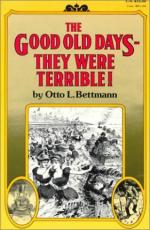
|
| Name: _________________________ | Period: ___________________ |
This test consists of 15 multiple choice questions and 5 short answer questions.
Multiple Choice Questions
1. According to Bettmann, what was the homemade frontier liquor made from?
(a) Corn.
(b) Grapes.
(c) Apples.
(d) Beets.
2. In the late 1800s, why would a cop be encouraged to beat up a perpetrator?
(a) Self defense.
(b) Violence was the only control they had.
(c) They were awarded for violence.
(d) To have something to show in court.
3. Which part of the population got to enjoy the luxuries of ocean liners in the late 19th century?
(a) The rich.
(b) Politicians.
(c) Foreign dignitaries.
(d) Immigrants.
4. In 1890, how many prostitutes were estimated to be living in New York City?
(a) 25,000.
(b) 40,000.
(c) 10,000.
(d) 5,000.
5. What was a chief concern with train travel in the late 1800s?
(a) Personal safety.
(b) Being on schedule.
(c) Lost luggage.
(d) Overcrowding.
6. What were doctors on the frontier in the late 1800s thought to have been?
(a) Worthless quacks.
(b) Needed and appreciated.
(c) Quality physicians.
(d) Better than nothing.
7. According to Bettmann in "Crime," how did juvenile delinquency affect the large cities?
(a) With rampant kidnappings.
(b) With lack of school attendance.
(c) With large scale gambling.
(d) With organized youth gangs.
8. According to Bettmann in "Food and Drink," in what condition were the cows when they arrived at the slaughterhouse?
(a) Fattened up by feed.
(b) Tainted with disease.
(c) Starved and sickly.
(d) Fattened up by steroids.
9. What characterized American eating habits in the post Civil War era?
(a) People only ate what they could grow.
(b) Gorging and speed.
(c) Eating primarily fast food.
(d) Eating only the most healthful foods.
10. What was "swill" milk?
(a) Milk from cows that were fed waste.
(b) Milk from goats.
(c) Milk that had gone bad.
(d) Milk that was used for medicinal purposes.
11. How were the prisoners in the prison system treated in the post Civil War era?
(a) They were treated according to their crimes.
(b) Like subhuman species.
(c) Although incarcerated they were treated with respect.
(d) Much as prisoners today are treated.
12. What did teaching methods of the late 19th century emphasize?
(a) Recitation and obedience.
(b) Skill mastery.
(c) How to learn a craft.
(d) Memorization of dull facts.
13. According to Bettmann in "Health," medical colleges were designed primarily to do what?
(a) Educate doctors.
(b) Eradicate disease.
(c) Make money off of tuition.
(d) Send out qualified physicians to the frontier.
14. In the late 19th century, how did families deal with members who had mental illnesses?
(a) They drugged them.
(b) They hid them.
(c) They took them for treatment.
(d) They had them sent away.
15. What was blamed for the cholera epidemic in 1832?
(a) Unclean water.
(b) Unsanitary restaurants.
(c) Tainted Meat.
(d) Vegetables.
Short Answer Questions
1. In the late 1800s, how did city politics affect the criminal justice system?
2. When was opium introduced?
3. What did the police often do with offending boys in the late 1800s?
4. Between 1860 and 1890, how much did the crime rate go up?
5. What other problems did city schools face in the post Civil War era?
|
This section contains 515 words (approx. 2 pages at 300 words per page) |

|




